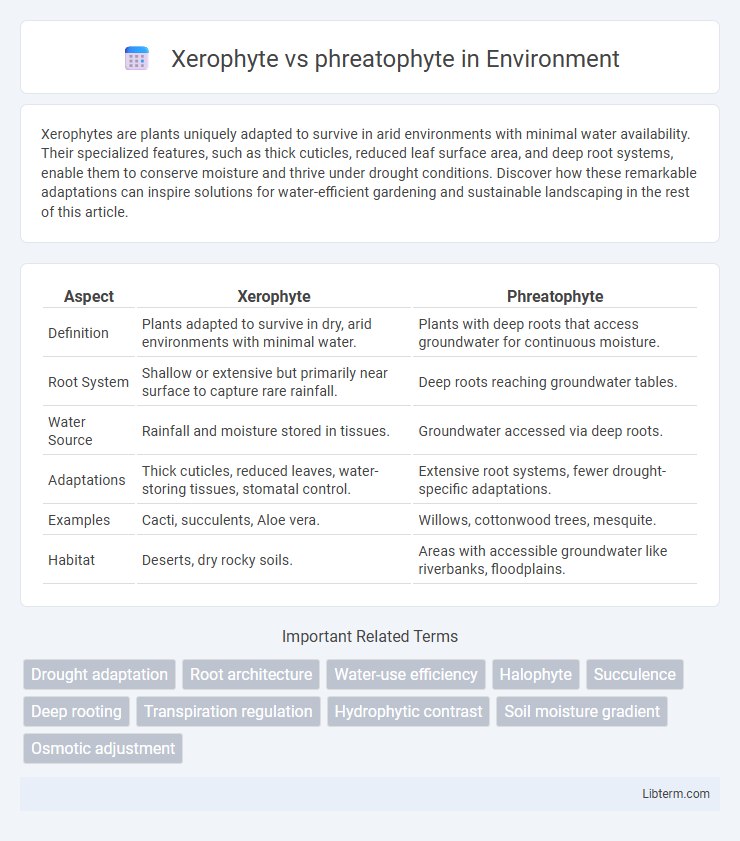Xerophytes are plants uniquely adapted to survive in arid environments with minimal water availability. Their specialized features, such as thick cuticles, reduced leaf surface area, and deep root systems, enable them to conserve moisture and thrive under drought conditions. Discover how these remarkable adaptations can inspire solutions for water-efficient gardening and sustainable landscaping in the rest of this article.
Table of Comparison
| Aspect | Xerophyte | Phreatophyte |
|---|---|---|
| Definition | Plants adapted to survive in dry, arid environments with minimal water. | Plants with deep roots that access groundwater for continuous moisture. |
| Root System | Shallow or extensive but primarily near surface to capture rare rainfall. | Deep roots reaching groundwater tables. |
| Water Source | Rainfall and moisture stored in tissues. | Groundwater accessed via deep roots. |
| Adaptations | Thick cuticles, reduced leaves, water-storing tissues, stomatal control. | Extensive root systems, fewer drought-specific adaptations. |
| Examples | Cacti, succulents, Aloe vera. | Willows, cottonwood trees, mesquite. |
| Habitat | Deserts, dry rocky soils. | Areas with accessible groundwater like riverbanks, floodplains. |
Introduction to Xerophytes and Phreatophytes
Xerophytes are plants adapted to survive in arid environments with minimal water availability, featuring specialized structures such as thick cuticles, reduced leaf areas, and deep root systems to conserve moisture. Phreatophytes, on the other hand, are deep-rooted plants that access groundwater by extending their roots to the phreatic zone, enabling them to thrive in dry regions with fluctuating surface water. Both plant types play critical roles in ecosystems by efficiently managing water resources and sustaining vegetation in drought-prone habitats.
Defining Xerophytes: Key Characteristics
Xerophytes are plants uniquely adapted to thrive in arid environments with scarce water availability, exhibiting key characteristics such as thick, waxy cuticles to reduce water loss, deep or extensive root systems for maximizing water absorption, and specialized leaf structures like spines or reduced leaf surface area to minimize transpiration. These adaptations enable xerophytes to maintain cellular hydration and survive prolonged drought conditions. In contrast, phreatophytes rely on accessing groundwater through deep roots, typically found in riparian or water-abundant ecosystems, highlighting a fundamental ecological difference in water acquisition strategies.
Understanding Phreatophytes: Core Features
Phreatophytes are deep-rooted plants that access groundwater through extensive root systems, enabling survival in arid environments with limited surface moisture. Unlike xerophytes, which conserve water through morphological adaptations like thick cuticles and reduced leaf areas, phreatophytes rely on stable groundwater sources to maintain physiological processes. Key characteristics include high transpiration rates, deep taproots, and the ability to thrive in regions with fluctuating rainfall but consistent groundwater availability.
Habitat Differences: Dry vs. Moist Environments
Xerophytes thrive in arid, dry environments by adapting to limited water availability through features such as thick cuticles and deep root systems. In contrast, phreatophytes inhabit moist environments with access to deep groundwater, often developing extensive root networks that reach water tables for sustained hydration. These habitat differences drive distinct physiological adaptations optimizing water use efficiency and survival strategies in their respective ecosystems.
Water Acquisition Strategies
Xerophytes acquire water primarily through specialized adaptations such as thick cuticles, reduced leaf surface area, and deep or widespread root systems to minimize water loss and maximize water uptake from dry, arid environments. Phreatophytes access water by extending their roots deep into the groundwater table, enabling continuous water absorption even during prolonged droughts. These contrasting water acquisition strategies reflect xerophytes' adaptation to scarce surface moisture and phreatophytes' reliance on stable underground water sources.
Morphological Adaptations Comparison
Xerophytes exhibit thick cuticles, sunken stomata, and reduced leaf surface area to minimize water loss in arid conditions, while phreatophytes develop extensive root systems that penetrate deep water tables to access groundwater. Xerophytes often have succulent tissues for water storage, contrasting with phreatophytes' reliance on deep root architecture rather than foliar modifications. Both adaptations optimize survival, but xerophytes emphasize water conservation above ground, whereas phreatophytes prioritize water acquisition below ground.
Physiological Mechanisms in Xerophytes and Phreatophytes
Xerophytes employ physiological mechanisms such as thick cuticles, reduced stomatal density, and CAM photosynthesis to minimize water loss and maximize water use efficiency in arid environments. Phreatophytes rely on deep root systems to access groundwater, enabling sustained transpiration and nutrient uptake even during drought conditions. Both plant types exhibit specialized adaptations to regulate water uptake and retention, optimizing survival under different hydrological constraints.
Examples of Common Xerophytes and Phreatophytes
Common xerophytes include cacti such as the saguaro (Carnegiea gigantea) and succulents like aloe vera, which are adapted to survive in arid environments with minimal water. Phreatophytes, such as cottonwood trees (Populus deltoides) and mesquite (Prosopis spp.), are deep-rooted plants that access groundwater in semi-arid or arid regions. These species demonstrate specialized adaptations for water acquisition, with xerophytes minimizing water loss and phreatophytes tapping into deep water sources.
Ecological Roles in Their Respective Ecosystems
Xerophytes play a critical role in arid ecosystems by conserving water and stabilizing soil, thereby supporting biodiversity in harsh, drought-prone environments. Phreatophytes maintain groundwater levels through deep root systems that tap into aquifers, providing essential moisture to surrounding vegetation and sustaining riparian habitats. Both plant types contribute to their ecosystems' resilience by adapting to water availability extremes and influencing hydrological cycles.
Xerophyte vs. Phreatophyte: Summary Table and Key Takeaways
Xerophytes are plants adapted to survive in arid environments with minimal water, featuring characteristics like thick cuticles, reduced leaf surface, and deep root systems to conserve moisture. Phreatophytes, on the other hand, have extensive root systems that tap into groundwater resources, enabling them to thrive in areas with accessible water despite surface dryness. The summary table highlights key distinctions such as xerophytes' drought resistance through water retention versus phreatophytes' reliance on phreatic water, making both crucial for ecosystem functioning in dry habitats.
Xerophyte Infographic

 libterm.com
libterm.com